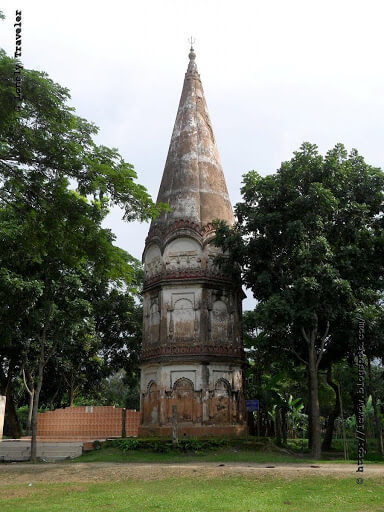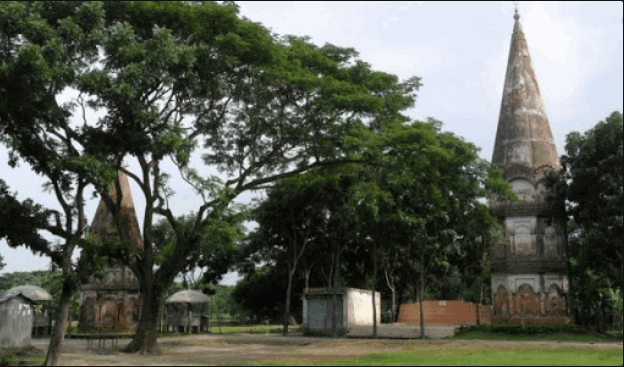
‘Childhood companion, you are the companion of youth,
Forgive the crime, you know Chandrabati is a sinner,
Don’t say goodbye,
Say goodbye, like Chandrabati, is born’
The above lines were composed for Chandrabati, Jayananda, the childhood lover of the author Chandrabati. Witnessing a tragic history, this line is still adorned at the entrance of the hundred-year-old Chandrabati temple. Who was this Chandrabati? What was the result of the love between Chandrabati and Jayananda? Where is this Chandrabati temple? Today’s article will try to answer these questions.
Poet Chandrabati was the first female poet of Bengali literature. Chandrabati, the daughter of Dwijbangshi Das and Sulochana Das, the author of Manasamangal, a famous example of sixteenth-century Bengali literature, was born in 1550 in the village of Patuair in present-day Kishoreganj.
Only 6 km away from Kishoreganj town, this village of Patuai was once on the banks of the Fuleshwari river, of which there is no trace today. This original female poet of Bengali literature grew up on this riverbank. Like Baba Dwijbangshi Das, Chandrabati was simultaneously a Bhasan poet, lyricist, and composer of Ramayana. Around 1575, the poet composed Bhasa of Manasa Devi with his father.
Table of Contents
Kobi Chandrabati Mandir Kacharipara Kishoreganj

Chandrabati started composing Ramayana from Sita’s point of view by criticizing Rama. The collector of ‘Mymensingh Geetika’, Dr. Dinesh Chandra Sen, published the Ramayana written by Chandrabati. Mymensingh lyricist is also involved in the story of love, poetry, and separation of this first successful female poet of Bengali literature.
There is a separation associated with this temple of the poet Chandrabati. Poet Chandrabati was in love with Jayananda of Sundha village in the adjoining Karimganj Upazila. Jayananda was his playmate and childhood friend. Once the childhood friendship of the two turned into love, the marriage was arranged with the consent of the two families.
But in the meantime, Jayananda fell in love with a local Muslim girl and converted and married her. The news broke Chandrabati’s heart and she vowed to remain a virgin for life. At Chandrabati’s request, Dwijbangshi Das Fuleshwari set up two temples on the banks of the river. Chandrabati started worshiping Shiva in both these temples. At one point, realizing her mistake, her lover Jayananda returned to the temple, but the arrogant Chandrabati’s mind did not melt.
In a state of despair, Jayananda wrote the above eloquent poem with the evening flower on the door of the temple, jumped into the Fuleshwari river, and later sacrificed himself. Disillusioned, he went to fetch water from the river to sanctify the Chandra temple, but when he could not bear to see Jayananda’s body, he too jumped to his death.
The legendary female writer is thought to have died around 1600 AD, ending an anecdote of separation. Although the Fuleshwari river does not exist at present, the two temples with the memory of the poet Chandrabati stand tall in their glory. Basically, the two temples are Shiva temples.
The two temples are a little smaller than each other. The original temple is octagonal in shape. About 32 feet in height, the length of each of the eight arms is about 8 feet. The ground floor of this two-storied temple has an entrance and 7 niches.
The second floor has a spacious niche and lovely terracotta work. From the second floor, the temple has gradually narrowed and reached a height of 32 feet. Some renovations were carried out here in 1990 by the Department of Archeology. In addition to the two temples, there is a nearly ruined two-story residence, which according to locals is believed to be the ancestor of the poet Chandrabati, the zamindar Nilakantha Roy.
Many tourists come to see this Chandrabati temple on holidays and in the afternoon. You can also spend an afternoon here. Maybe there is no fast-flowing river Fuleshwari, no Chandrabati or Jayananda, but every brick and door frame of this temple seems to be telling the story of that hundred-year-old sad separation.
Chandrabati’s Dasyu Kenaram’s Pala, Malua Lokpala, or Ramayana’s story seems to still float in the air of this region and at the same time, it tells the story of happiness, sorrow, and livelihood of the people of the Bhati region. All that can be heard as soon as the ears are thin. You can hear that legend and at the same time, you can see Itna Haor, Itna Shahi Mosque, Nikli Haor, the residence of Zamindar Gurudayal Chowdhury, etc. from Kishoreganj.
How To Go Poet Chandrabati Shiv Mandir
If you want to go to the temple of poet Chandrabati, you have to go to Kishoreganj district headquarters from any part of the country first. From Dhaka’s Golapbagh, Sayedabad and Mohakhali, BRTC, Ananya, Ananya Classic, Jalsiri, Jatayat etc. AC / Non-AC buses leave for Kishoreganj. The fare from Dhaka to Kishoreganj is 150 to 250 Tk. It will take two and a half to 3 hours.
You have to get down in Kishoreganj and go by easy bike or rickshaw in front of Shahidi Mosque. Rent is 10 Tk for an easy bike and 25-30 Tk for a rickshaw. From the front of Shahidi Mosque, you have to get on the Nilganj-bound autorickshaw and get off at Chairman Bazar. The signboard of the house of the poet Chandrabati can be seen on the main road, you can see the temple of the poet Chandrabati just ten minutes after crossing the bridge over the Narsunda river along the road on the right.
You can also take an auto directly from Shahidi Mosque to this temple. Besides, to get on the train, one has to take the Egarasindur Express from Kamalapur or Airport Railway Station to Kishoreganj. The Shahidi Masjid area of the city can be reached from the station with an autorickshaw fare of only Tk.5 Then you can go to the temple of the poet Chandrabati in the above-mentioned way.
Visit More Traveling Places:
Frequently Asked Question:
- Chandrabati Temple, Kishoreganj
- Kobi Chondraboti Shib Mandir
- Poet Chandrabati Shiv Mandir, Kacharipara, Kishoreganj
- Chandrabati Temple, Kishoreganj
- Kobi Chondraboti Shib Mandir
- Poet Chandrabati Shiv Mandir, Kacharipara, Kishoreganj
- Nikli haor kishoreganj
- Nikli haor kishoreganj distance from dhaka
- Famous food of kishoreganj
- What is kishoreganj famous for
- Kishoreganj map
- Kishoreganj to mymensingh
- My home district is kishoreganj
